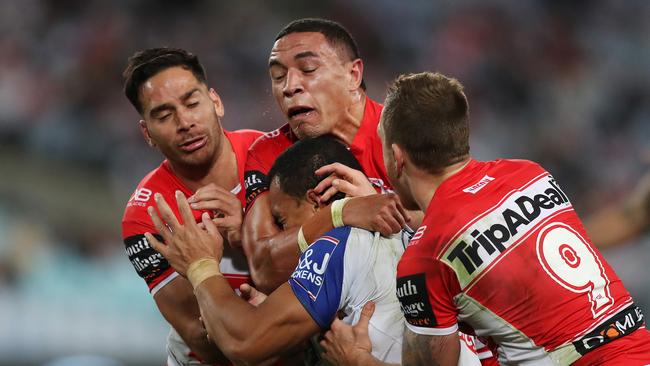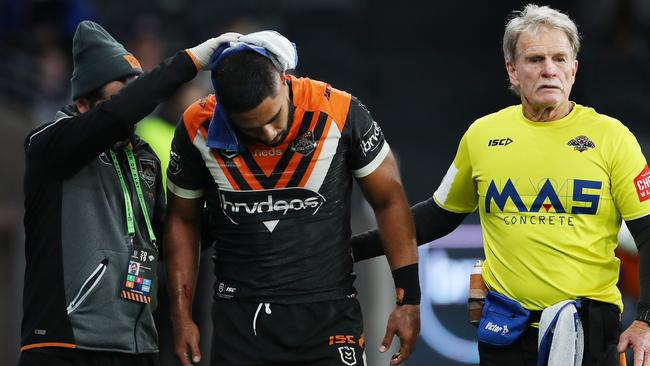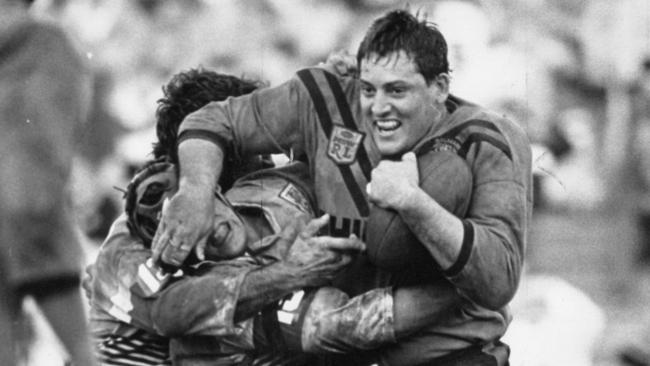Monday Buzz: The rules revamp that would change rugby league forever
As the threat of concussion litigation looms, it is clear that rugby league must respond if it is to survive and thrive. So what can be done to take the NRL into the future? PHIL ROTHFIELD has some suggestions. VOTE NOW IN OUR POLL.

NRL
Don't miss out on the headlines from NRL. Followed categories will be added to My News.
- Brutal truth: Is the NRL too tough?
- NRL pays price for crippling injury toll
- Buzz: Pay’s days at Bulldogs numbered
- Why Pearce owes Newcastle everything
Will rugby league be preparing for a State of Origin decider in 20 years’ time?
Or will the game be dead by then, killed off by the very real threat of concussion litigation?
Even the most hardened rugby league types are finally conceding something needs to be done for the toughest body contact sport in the world to survive for another 100-odd years.
The horrible after effects of head injuries are now being revealed from an era when footballers were much smaller and far less physical.
Players these days are 30kg heavier than the ‘70s. Bigger, stronger, faster and more powerful athletes have made the collisions and dangers far greater, despite improved protocols.

Last year the intensity of collisions rose to an all-time high according to NRL measurements because of the huge increase in penalty stoppages.
With a more free-flowing game and more ball-in-play time this year, the same research shows the force of collisions has dropped substantially because of less energy in attack and defence.
Here are a number of options to make the games safer, not just in the NRL but the junior ranks.
CHANGE KICK-OFF RESTARTS
The intelligent and well-researched James Graham raised this one on NRL360 last week.
The most brutal and dangerous collisions in the modern game are front-rowers returning the football from their in-goal area at full speed and then hurtling themselves into up to three defenders charging from the opposite direction. It can have the force of a car crash.
We all love the gladiatorial element of the game. We love that first hit-up on Origin night.
But for head injuries, it’s probably the most dangerous play in the game.
The introduction of a 25m line for kick restarts would be an option. We’d have shorter kick-offs and a contest for possession that would give the game more unpredictability.
12-A-SIDE TEAMS
One less player would open up the game, increase fatigue and slightly soften the impact in tackles.
It has been spoken about for years but never properly considered as a legitimate option.
The lock forward would probably be the position that goes.
Look at Nines football. The emphasis is on speed and skill. You need pace more than power.
There are less concussions because you can only afford to have one or two in the tackles.
TACKLE BELOW THE ARMPITS
This rule has been already trialled in English rugby union. There was a 41 per cent decrease in the number of tackles where contact was made with the head or neck of the ball carrier.
A black line is stitched onto jerseys to make it clearer for defenders.
Anyone who goes above the black line is penalised or the attacking team gets a tackle-count restart.
We’d still get the big hits and the big contact but a reduction in head injuries.

LIMIT OF TWO PER TACKLE
This is the one big Steve “Blocker” Roach loves.
“The third man in diving at the legs can cause a lot of angst,” Roach says.
“Two in a tackle should be enough. It would also promote the use of the football and more offloads.
“Front-rowers these days just eat metres and play the ball as quick as they can.
“That’s not skilful and doesn’t bring people to the game. We need more ball-playing forwards like Jake Trbojevic.”
From a player safety view, it’s obviously far less dangerous being hit by the 230kg weight of two players rather than up 350kg.

REDUCE THE 10M RULE
Bringing the 10m back to 7m would reduce the impact and force of collisions that’s worth consideration.
In the old days teams were kept only five metres apart. It was changed to open up the game and give teams more space and time to use the football.
The line speed these days with fitter and faster players would be the concern but it’s at least worth looking at in a trial game.

REDUCE INTERCHANGE
There is a huge debate about the effect of limiting teams to six interchanges instead of eight.
We all agree this would create more fatigue and allow the smaller, faster more skilful players the space to work their magic.
Tired forwards would become an endangered species. There are however theories that more fatigue will result in more injuries and more accidental high tackles.
Like all of the above options, it’s worth a debate.
In 2039 we want to be gearing up for another Origin decider, not mourning the death of the greatest game of all.
Don’t laugh. The concussion threat is that serious. And, fortunately, the NRL is treating it as such.


